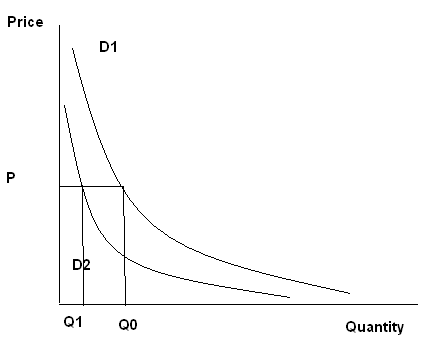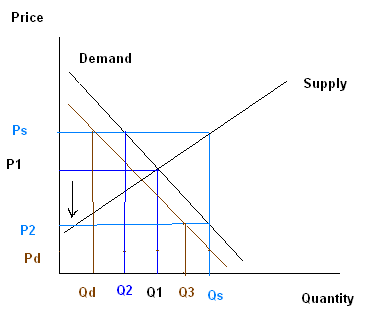The market mechanism in determining the demand and supply of goods is driven by changes in price. But that is in a situation when citrus Paribus is assumed. Further, the demand and supply of the good also affect the overall revenue of the company. The article about the stagnant DVD demand and the reducing profit of entertainment companies has been highlighted in the article (Barnes). In this essay, we will discuss the influence of changing demand of DVDs and high definition disks and their prices in the market, and how their price reduction and sagging demand have affected company revenue.
The demand for DVDs has been declining since 2005. This is the case even with declining prices of the product. Hence, we see the demand curve for DVDs has shifted leftward which implies one of the factors that remained constant had changed. One reason for this could introduction of alternatives i.e. increased competition. MP3s and MP4s are strong competitive forces to DVDs. MP3s have become cheaper and so are digital downloads. So an increase in competition for DVDs is driving down demand. Another reason attributable to this shift is the economic recession in the United States. This has shifted the demand for DVDs. Diagrammatically we see the as the demand curve shifts to the left, at a price P, the demand for DVDs declines from Q0 to Q1.

Further, in the case of DVDs, there has been a decline in the price of the product too. This is because of increased supply. As reported: “Media companies, desperate for revenue, are dumping more obscure titles on the market, leading to downward pricing pressure, according to Distribution Video and Audio, a home entertainment overstock company in Burbank, Calif. Consumers are being more selective.” (Barnes) This shows that an increase in the supply of DVDs has pushed the price of the product. As figure 2 shows the sale of DVDs had reached equilibrium at price P1 and demand Q1 but as the supply from the producers went, up to Qs the demand for DVDs fell to Q2 and the equilibrium position was disturbed. Further, due to changes in the cetirus paribus assumption, the quantity demanded at the current supply fell further down to Qd. Hence, there was a decline in total revenue from P1Q1 to P2Q3.

The article clearly shows that, as there is an increase in the supply of DVDs, the prices are pushed down due to the interplay of the market forces. The quantity demanded dropped further due to a leftward shift of the demand curve due to changes in demand for its substitutes. This demand and supply mechanism demonstrates why there has been a slump in the demand for DVDs and how an increased supply had brought down prices of the product. Now cost structure remaining same, the cost of making of one DVD will remain same, it is sold at a lesser price than earlier. As the revenue from one unit of DVD falls the profit from one unit of DVD falls. Clearly, there is a decline in the profit of the DVD producers. This also explains the statement in the article: “DVDs propel profits these days, and there is a creeping dread in the movie capital that buyer interest is plummeting as the global economic crisis worsens.” (Barnes) This shows as the DVD sales are 70 percent of the producer’s profit, there is expected to be a decline in the profit too (Barnes) which supports our microeconomic analysis of the industry.
References
Barnes, Brooks. “DVDs, Hollywood’s Profit Source, Are Sagging (Los Angeles).” 2008. The New York Times. Web.